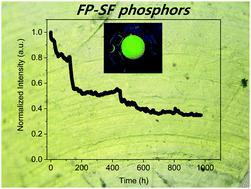当前位置:
X-MOL 学术
›
Mater. Horiz.
›
论文详情
Our official English website, www.x-mol.net, welcomes your
feedback! (Note: you will need to create a separate account there.)
Biogenic fluorescent protein–silk fibroin phosphors for high performing light-emitting diodes
Materials Horizons ( IF 12.2 ) Pub Date : 2020-05-22 , DOI: 10.1039/d0mh00503g Verónica Fernández-Luna 1, 2, 3, 4, 5 , Juan P. Fernández-Blázquez 1, 2, 3 , Miguel A. Monclús 1, 2, 3 , Francisco Javier Rojo 3, 6, 7, 8 , Rafael Daza 3, 6, 7, 8 , Daniel Sanchez-deAlcazar 3, 9, 10, 11 , Aitziber L. Cortajarena 3, 9, 10, 11, 12 , Rubén D. Costa 1, 2, 3, 13, 14
Materials Horizons ( IF 12.2 ) Pub Date : 2020-05-22 , DOI: 10.1039/d0mh00503g Verónica Fernández-Luna 1, 2, 3, 4, 5 , Juan P. Fernández-Blázquez 1, 2, 3 , Miguel A. Monclús 1, 2, 3 , Francisco Javier Rojo 3, 6, 7, 8 , Rafael Daza 3, 6, 7, 8 , Daniel Sanchez-deAlcazar 3, 9, 10, 11 , Aitziber L. Cortajarena 3, 9, 10, 11, 12 , Rubén D. Costa 1, 2, 3, 13, 14
Affiliation

|
This work presents a new family of bio-hybrid light-emitting diodes (Bio-HLEDs) using all-bio color down-converting coatings that combine silk fibroin (SF) as a packaging matrix and fluorescent proteins (FPs) as emitters. The thermal, mechanical, optical, and luminescent features of the FP–SF bio-phosphors were optimized with respect to the blend composition and the FP stability under thermal and irradiation stress. Bio-HLEDs with FP–SF filters feature stabilities of 1.2 h and 500 h (200 mA) at efficiencies of ∼40 lm W−1 for on-chip and remote configurations, respectively. This is significantly superior to devices with FP–polymer bio-phosphors – i.e., 1.8 min (on-chip) and 300 h (remote) at <35 lm W−1. The excellence of the biogenic phosphors is attributed to (i) the ideal optical features of the SF films, (ii) the highly efficient emission of the FPs, and (iii) the high thermal- and photo-stabilities of FPs in the SF matrix. Finally, we revealed that the emission deactivation process of FP–SF phosphors is related to a very slow protonation of the ionic form of the FP chromophore along with large morphological changes due to thermal- and photo-induced FP motions. Overall, this work shows the promising prospects of fully biogenic phosphors en route to designing highly stable bio-based lighting devices.
中文翻译:

生物荧光蛋白-丝素蛋白荧光粉,用于高性能发光二极管
这项工作提出了一个新的生物混合型发光二极管(Bio-HLED)系列,该系列使用全生物彩色降频转换涂层,该涂层结合了丝素蛋白(SF)作为包装基质和荧光蛋白(FPs)作为发射体。FP-SF生物磷光体的热,机械,光学和发光特性针对共混物组成和FP在热和辐射应力下的稳定性进行了优化。带有FP–SF滤波器的Bio-HLED在芯片和远程配置下的稳定性分别为1.2 h和500 h(200 mA),效率约为40 lm W -1。这显着优于具有FP聚合物生物荧光粉的设备,即在小于35 lm W -1的条件下为1.8分钟(片上)和300小时(远程)。。生物荧光粉的卓越表现归因于(i)SF膜的理想光学特性,(ii)FP的高效发射以及(iii)SF基质中FP的高热稳定性和光稳定性。最后,我们揭示了FP–SF荧光粉的发射失活过程与FP发色团的离子形式的非常缓慢的质子化以及由于热和光诱导FP运动引起的大形态变化有关。总的来说,这项工作显示出在设计高度稳定的基于生物的照明设备的过程中,全生物荧光粉的前景广阔。
更新日期:2020-07-06
中文翻译:

生物荧光蛋白-丝素蛋白荧光粉,用于高性能发光二极管
这项工作提出了一个新的生物混合型发光二极管(Bio-HLED)系列,该系列使用全生物彩色降频转换涂层,该涂层结合了丝素蛋白(SF)作为包装基质和荧光蛋白(FPs)作为发射体。FP-SF生物磷光体的热,机械,光学和发光特性针对共混物组成和FP在热和辐射应力下的稳定性进行了优化。带有FP–SF滤波器的Bio-HLED在芯片和远程配置下的稳定性分别为1.2 h和500 h(200 mA),效率约为40 lm W -1。这显着优于具有FP聚合物生物荧光粉的设备,即在小于35 lm W -1的条件下为1.8分钟(片上)和300小时(远程)。。生物荧光粉的卓越表现归因于(i)SF膜的理想光学特性,(ii)FP的高效发射以及(iii)SF基质中FP的高热稳定性和光稳定性。最后,我们揭示了FP–SF荧光粉的发射失活过程与FP发色团的离子形式的非常缓慢的质子化以及由于热和光诱导FP运动引起的大形态变化有关。总的来说,这项工作显示出在设计高度稳定的基于生物的照明设备的过程中,全生物荧光粉的前景广阔。











































 京公网安备 11010802027423号
京公网安备 11010802027423号